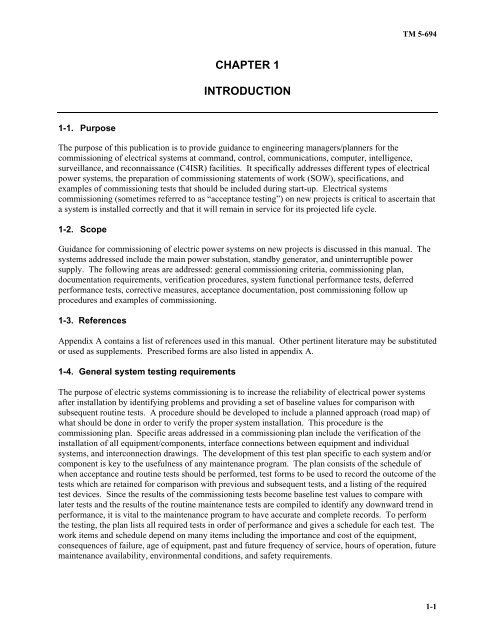Commissioning of Electrical Systems for Command, Control
Commissioning of Electrical Systems for Command, Control
Commissioning of Electrical Systems for Command, Control
Create successful ePaper yourself
Turn your PDF publications into a flip-book with our unique Google optimized e-Paper software.
1-1. Purpose<br />
CHAPTER 1<br />
INTRODUCTION<br />
TM 5-694<br />
The purpose <strong>of</strong> this publication is to provide guidance to engineering managers/planners <strong>for</strong> the<br />
commissioning <strong>of</strong> electrical systems at command, control, communications, computer, intelligence,<br />
surveillance, and reconnaissance (C4ISR) facilities. It specifically addresses different types <strong>of</strong> electrical<br />
power systems, the preparation <strong>of</strong> commissioning statements <strong>of</strong> work (SOW), specifications, and<br />
examples <strong>of</strong> commissioning tests that should be included during start-up. <strong>Electrical</strong> systems<br />
commissioning (sometimes referred to as “acceptance testing”) on new projects is critical to ascertain that<br />
a system is installed correctly and that it will remain in service <strong>for</strong> its projected life cycle.<br />
1-2. Scope<br />
Guidance <strong>for</strong> commissioning <strong>of</strong> electric power systems on new projects is discussed in this manual. The<br />
systems addressed include the main power substation, standby generator, and uninterruptible power<br />
supply. The following areas are addressed: general commissioning criteria, commissioning plan,<br />
documentation requirements, verification procedures, system functional per<strong>for</strong>mance tests, deferred<br />
per<strong>for</strong>mance tests, corrective measures, acceptance documentation, post commissioning follow up<br />
procedures and examples <strong>of</strong> commissioning.<br />
1-3. References<br />
Appendix A contains a list <strong>of</strong> references used in this manual. Other pertinent literature may be substituted<br />
or used as supplements. Prescribed <strong>for</strong>ms are also listed in appendix A.<br />
1-4. General system testing requirements<br />
The purpose <strong>of</strong> electric systems commissioning is to increase the reliability <strong>of</strong> electrical power systems<br />
after installation by identifying problems and providing a set <strong>of</strong> baseline values <strong>for</strong> comparison with<br />
subsequent routine tests. A procedure should be developed to include a planned approach (road map) <strong>of</strong><br />
what should be done in order to verify the proper system installation. This procedure is the<br />
commissioning plan. Specific areas addressed in a commissioning plan include the verification <strong>of</strong> the<br />
installation <strong>of</strong> all equipment/components, interface connections between equipment and individual<br />
systems, and interconnection drawings. The development <strong>of</strong> this test plan specific to each system and/or<br />
component is key to the usefulness <strong>of</strong> any maintenance program. The plan consists <strong>of</strong> the schedule <strong>of</strong><br />
when acceptance and routine tests should be per<strong>for</strong>med, test <strong>for</strong>ms to be used to record the outcome <strong>of</strong> the<br />
tests which are retained <strong>for</strong> comparison with previous and subsequent tests, and a listing <strong>of</strong> the required<br />
test devices. Since the results <strong>of</strong> the commissioning tests become baseline test values to compare with<br />
later tests and the results <strong>of</strong> the routine maintenance tests are compiled to identify any downward trend in<br />
per<strong>for</strong>mance, it is vital to the maintenance program to have accurate and complete records. To per<strong>for</strong>m<br />
the testing, the plan lists all required tests in order <strong>of</strong> per<strong>for</strong>mance and gives a schedule <strong>for</strong> each test. The<br />
work items and schedule depend on many items including the importance and cost <strong>of</strong> the equipment,<br />
consequences <strong>of</strong> failure, age <strong>of</strong> equipment, past and future frequency <strong>of</strong> service, hours <strong>of</strong> operation, future<br />
maintenance availability, environmental conditions, and safety requirements.<br />
1-1
















